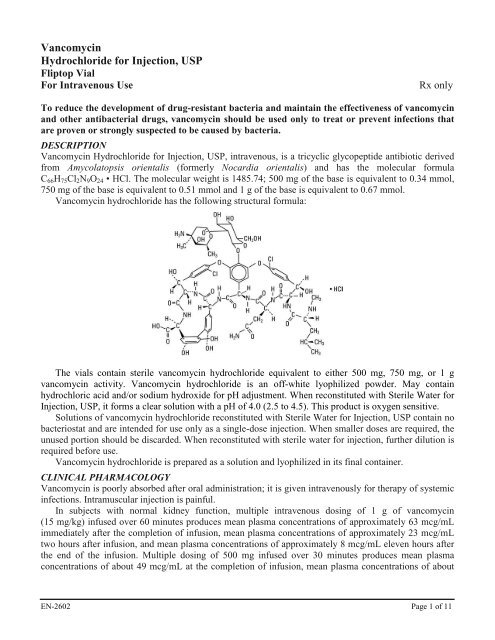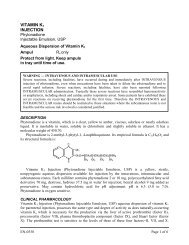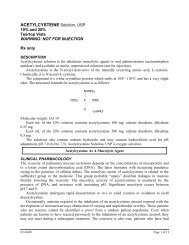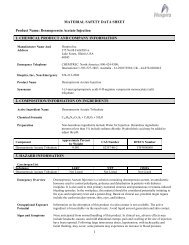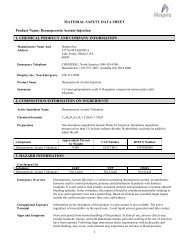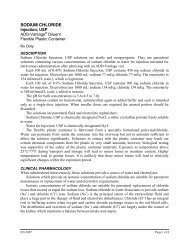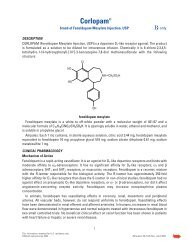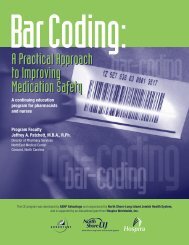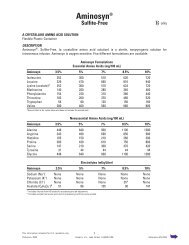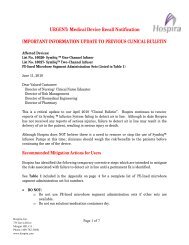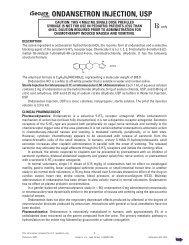Vancomycin Hydrochloride for Injection, USP (750 mg fliptop - Hospira
Vancomycin Hydrochloride for Injection, USP (750 mg fliptop - Hospira
Vancomycin Hydrochloride for Injection, USP (750 mg fliptop - Hospira
You also want an ePaper? Increase the reach of your titles
YUMPU automatically turns print PDFs into web optimized ePapers that Google loves.
<strong>Vancomycin</strong><br />
<strong>Hydrochloride</strong> <strong>for</strong> <strong>Injection</strong>, <strong>USP</strong><br />
Fliptop Vial<br />
For Intravenous Use Rx only<br />
To reduce the development of drug-resistant bacteria and maintain the effectiveness of vancomycin<br />
and other antibacterial drugs, vancomycin should be used only to treat or prevent infections that<br />
are proven or strongly suspected to be caused by bacteria.<br />
DESCRIPTION<br />
<strong>Vancomycin</strong> <strong>Hydrochloride</strong> <strong>for</strong> <strong>Injection</strong>, <strong>USP</strong>, intravenous, is a tricyclic glycopeptide antibiotic derived<br />
from Amycolatopsis orientalis (<strong>for</strong>merly Nocardia orientalis) and has the molecular <strong>for</strong>mula<br />
C66H75Cl2N9O24 • HCl. The molecular weight is 1485.74; 500 <strong>mg</strong> of the base is equivalent to 0.34 mmol,<br />
<strong>750</strong> <strong>mg</strong> of the base is equivalent to 0.51 mmol and 1 g of the base is equivalent to 0.67 mmol.<br />
<strong>Vancomycin</strong> hydrochloride has the following structural <strong>for</strong>mula:<br />
The vials contain sterile vancomycin hydrochloride equivalent to either 500 <strong>mg</strong>, <strong>750</strong> <strong>mg</strong>, or 1 g<br />
vancomycin activity. <strong>Vancomycin</strong> hydrochloride is an off-white lyophilized powder. May contain<br />
hydrochloric acid and/or sodium hydroxide <strong>for</strong> pH adjustment. When reconstituted with Sterile Water <strong>for</strong><br />
<strong>Injection</strong>, <strong>USP</strong>, it <strong>for</strong>ms a clear solution with a pH of 4.0 (2.5 to 4.5). This product is oxygen sensitive.<br />
Solutions of vancomycin hydrochloride reconstituted with Sterile Water <strong>for</strong> <strong>Injection</strong>, <strong>USP</strong> contain no<br />
bacteriostat and are intended <strong>for</strong> use only as a single-dose injection. When smaller doses are required, the<br />
unused portion should be discarded. When reconstituted with sterile water <strong>for</strong> injection, further dilution is<br />
required be<strong>for</strong>e use.<br />
<strong>Vancomycin</strong> hydrochloride is prepared as a solution and lyophilized in its final container.<br />
CLINICAL PHARMACOLOGY<br />
<strong>Vancomycin</strong> is poorly absorbed after oral administration; it is given intravenously <strong>for</strong> therapy of systemic<br />
infections. Intramuscular injection is painful.<br />
In subjects with normal kidney function, multiple intravenous dosing of 1 g of vancomycin<br />
(15 <strong>mg</strong>/kg) infused over 60 minutes produces mean plasma concentrations of approximately 63 mcg/mL<br />
immediately after the completion of infusion, mean plasma concentrations of approximately 23 mcg/mL<br />
two hours after infusion, and mean plasma concentrations of approximately 8 mcg/mL eleven hours after<br />
the end of the infusion. Multiple dosing of 500 <strong>mg</strong> infused over 30 minutes produces mean plasma<br />
concentrations of about 49 mcg/mL at the completion of infusion, mean plasma concentrations of about<br />
EN-2602 Page 1 of 11
19 mcg/mL two hours after infusion, and mean plasma concentrations of about 10 mcg/mL six hours after<br />
infusion. The plasma concentrations during multiple dosing are similar to those after a single dose.<br />
The mean elimination half-life of vancomycin from plasma is 4 to 6 hours in subjects with normal<br />
renal function. In the first 24 hours, about 75% of an administered dose of vancomycin is excreted in<br />
urine by glomerular filtration. Mean plasma clearance is about 0.058 L/kg/hr, and mean renal clearance is<br />
about 0.048 L/kg/hr. Renal dysfunction slows excretion of vancomycin. In anephric patients, the average<br />
half-life of elimination is 7.5 days. The distribution coefficient is from 0.3 to 0.43 L/kg. There is no<br />
apparent metabolism of the drug. About 60% of an intraperitoneal dose of vancomycin administered<br />
during peritoneal dialysis is absorbed systemically in six hours. Serum concentrations of about<br />
10 mcg/mL are achieved by intraperitoneal injection of 30 <strong>mg</strong>/kg of vancomycin.<br />
However, the safety and efficacy of the intraperitoneal use of vancomycin has not been established in<br />
adequate and well-controlled trials (see PRECAUTIONS).<br />
Total systemic and renal clearance of vancomycin may be reduced in the elderly.<br />
<strong>Vancomycin</strong> is approximately 55% serum protein bound as measured by ultrafiltration at vancomycin<br />
serum concentrations of 10 to 100 mcg/mL. After I.V. administration of vancomycin, inhibitory<br />
concentrations are present in pleural, pericardial, ascitic, and synovial fluids; in urine; in peritoneal<br />
dialysis fluid; and in atrial appendage tissue. <strong>Vancomycin</strong> does not readily diffuse across normal<br />
meninges into the spinal fluid; but, when the meninges are inflamed, penetration into the spinal fluid<br />
occurs.<br />
Microbiology- The bactericidal action of vancomycin results primarily from inhibition of cell-wall<br />
biosynthesis. In addition, vancomycin alters bacterial-cell-membrane permeability and RNA synthesis.<br />
There is no cross-resistance between vancomycin and other antibiotics. <strong>Vancomycin</strong> is not active in vitro<br />
against gram-negative bacilli, mycobacteria, or fungi.<br />
Synergy- The combination of vancomycin and an aminoglycoside acts synergistically in vitro against<br />
many strains of Staphylococcus aureus, Streptococcus bovis, enterococci, and the viridans group<br />
streptococci.<br />
<strong>Vancomycin</strong> has been shown to be active against most strains of the following microorganisms, both<br />
in vitro and in clinical infections as described in the INDICATIONS AND USAGE section.<br />
Aerobic gram-positive microorganisms<br />
Diphtheroids<br />
Enterococci (e.g., Enterococcus faecalis)<br />
Staphylococci, including Staphylococcus aureus and Staphylococcus epidermidis (including<br />
heterogeneous methicillin-resistant strains)<br />
Streptococcus bovis<br />
Viridans group streptococci<br />
The following in vitro data are available, but their clinical significance is unknown.<br />
<strong>Vancomycin</strong> exhibits in vitro MIC's of 1 mcg/mL or less against most (≥90%) strains of streptococci<br />
listed below and MIC's of 4 mcg/mL or less against most (≥90%) strains of other listed microorganisms;<br />
however, the safety and effectiveness of vancomycin in treating clinical infections due to these<br />
microorganisms have not been established in adequate and well-controlled clinical trials.<br />
Aerobic gram-positive microorganisms<br />
Listeria monocytogenes<br />
Streptococcus pyogenes<br />
Streptococcus pneumoniae (including penicillin-resistant strains)<br />
Streptococcus agalactiae<br />
EN-2602 Page 2 of 11
Anaerobic gram-positive microorganisms<br />
Actinomyces species<br />
Lactobacillus species<br />
Susceptibility Tests<br />
Dilution Techniques-Quantitative methods are used to determine antimicrobial minimum inhibitory<br />
concentrations (MIC's). These MIC's provide estimates of the susceptibility of bacteria to antimicrobial<br />
compounds. The MIC's should be determined using a standardized procedure. Standardized procedures<br />
are based on a dilution method 1 (broth or agar) or equivalent with standardized inoculum concentrations<br />
and standardized concentrations of vancomycin powder. The MIC values should be interpreted according<br />
to the following criteria:<br />
For testing aerobic microorganisms a other than streptococci:<br />
MIC (mcg/mL) Interpretation<br />
≤4 Susceptible (S)<br />
8-16 Intermediate (I)<br />
≥32 Resistant (R)<br />
a 7<br />
A beta-lactamase test using an inoculum ≥10 CFU/mL (or direct colony growth) and a nitrocefin-based<br />
substrate should be per<strong>for</strong>med to detect either ampicillin or penicillin resistance among enterococci due<br />
to beta-lactamase production.<br />
For testing streptococci b other than Streptococcus pneumoniae:<br />
MIC (mcg/mL) Interpretation<br />
≤1 Susceptible (S)<br />
b Interpretative criteria applicable only to tests per<strong>for</strong>med by broth microdilution method using cationadjusted<br />
Mueller-Hinton broth with 2 to 5% lysed horse blood 1 .<br />
The current absence of data on resistant strains precludes defining any categories other than<br />
“Susceptible”. Strains yielding MIC results suggestive of a “nonsusceptible” category should be<br />
submitted to a reference laboratory <strong>for</strong> further testing.<br />
A report of “Susceptible” indicates that the pathogen is likely to be inhibited if the antimicrobial<br />
compound in the blood reaches the concentrations usually achievable. A report of “Intermediate”<br />
indicates that the result should be considered equivocal, and, if the microorganism is not fully susceptible<br />
to alternative, clinically feasible drugs, the test should be repeated. This category implies possible clinical<br />
applicability in body sites where the drug is physiologically concentrated or in situations where high<br />
dosage of drug can be used. This category also provides a buffer zone which prevents small uncontrolled<br />
technical factors from causing major discrepancies in interpretation. A report of “Resistant” indicates that<br />
the pathogen is not likely to be inhibited if the antimicrobial compound in the blood reaches the<br />
concentrations usually achievable; other therapy should be selected.<br />
Standardized susceptibility test procedures require the use of laboratory control microorganisms to<br />
control the technical aspects of the laboratory procedures. Standard vancomycin powder should provide<br />
the following MIC values:<br />
EN-2602 Page 3 of 11
Microorganism MIC (mcg/mL)<br />
Enterococcus faecalis ATCC 29212 1-4<br />
Staphylococcus aureus ATCC 29213 0.5-2<br />
Streptococcus pneumoniae a ATCC 49619 0.12-0.5<br />
a<br />
Interpretative criteria applicable only to tests per<strong>for</strong>med by broth microdilution method using cationadjusted<br />
Mueller-Hinton broth with 2 to 5% lysed horse blood 1 .<br />
Diffusion Techniques–Quantitative methods that require measurement of zone diameters also provide<br />
reproducible estimates of the susceptibility of bacteria to antimicrobial compounds. One such<br />
standardized procedure 2 requires the use of standardized inoculum concentrations. This procedure uses<br />
paper disks impregnated with 30-mcg vancomycin to test the susceptibility of microorganisms to<br />
vancomycin.<br />
Reports from the laboratory providing results of the standard single-disk susceptibility test with a<br />
30-mcg vancomycin disk should be interpreted according to the following criteria:<br />
For testing aerobic microorganisms other than enterococci and streptococci:<br />
Zone Diameter (mm) Interpretation<br />
≥15 Susceptible (S)<br />
- Intermediate (I)<br />
- Resistant (R)<br />
For testing enterococci a,b :<br />
Zone Diameter (mm) Interpretation<br />
≥17 Susceptible (S)<br />
15-16 Intermediate (I)<br />
≤14 Resistant (R)<br />
a<br />
A direct nitrocefin-based beta-lactamase test using direct colony growth should be per<strong>for</strong>med to detect<br />
either ampicillin or penicillin resistance among enterococci due to beta-lactamase production.<br />
b<br />
When testing <strong>for</strong> enterococci resistance to vancomycin, plates should be held <strong>for</strong> a full 24 hours and<br />
examined using transmitted light. The presence of a haze or any growth within the zone of inhibition<br />
indicates resistance. Those enterococci with intermediate zones of inhibition should be tested by a<br />
standardized procedure based on a dilution method 1 (broth or agar) or equivalent.<br />
For testing streptococci c other than Streptococcus pneumoniae:<br />
Zone Diameter (mm) Interpretation<br />
≥17 Susceptible (S)<br />
c<br />
Interpretative criteria applicable only to tests per<strong>for</strong>med by disk diffusion method using Mueller-Hinton<br />
agar with 5% defibrinated sheep blood and incubated in 5% CO2 2 .<br />
The current absence of data on resistant strains precludes defining any categories other than<br />
"Susceptible". Strains yielding zone diameter results suggestive of a "nonsusceptible" category should be<br />
submitted to a reference laboratory <strong>for</strong> further testing.<br />
Interpretation should be as stated above <strong>for</strong> results using dilution techniques. Interpretation involves<br />
correlation of the diameter obtained in the disk test with the MIC <strong>for</strong> vancomycin.<br />
As with standardized dilution techniques, diffusion methods require the use of laboratory control<br />
microorganisms that are used to control the technical aspects of the laboratory procedures. For the<br />
EN-2602 Page 4 of 11
diffusion technique, the 30-mcg vancomycin disk should provide the following zone diameters in these<br />
laboratory test quality control strains:<br />
Microorganism Zone Diameter (mm)<br />
Staphylococcus aureus ATCC 25923 17-21<br />
Streptococcus pneumoniae a ATCC 49619 20-27<br />
a<br />
Interpretative criteria applicable only to tests per<strong>for</strong>med by disk diffusion method using Mueller-Hinton<br />
agar with 5% defibrinated sheep blood and incubated in 5% CO2 2 .<br />
INDICATIONS AND USAGE<br />
<strong>Vancomycin</strong> is indicated <strong>for</strong> the treatment of serious or severe infections caused by susceptible strains of<br />
methicillin-resistant (beta-lactam-resistant) staphylococci. It is indicated <strong>for</strong> penicillin-allergic patients,<br />
<strong>for</strong> patients who cannot receive or who have failed to respond to other drugs, including the penicillins or<br />
cephalosporins, and <strong>for</strong> infections caused by vancomycin-susceptible organisms that are resistant to other<br />
antimicrobial drugs. <strong>Vancomycin</strong> is indicated <strong>for</strong> initial therapy when methicillin-resistant staphylococci<br />
are suspected, but after susceptibility data are available, therapy should be adjusted accordingly.<br />
<strong>Vancomycin</strong> is effective in the treatment of staphylococcal endocarditis. Its effectiveness has been<br />
documented in other infections due to staphylococci, including septicemia, bone infections, lower<br />
respiratory tract infections, skin, and skin structure infections. When staphylococcal infections are<br />
localized and purulent, antibiotics are used as adjuncts to appropriate surgical measures.<br />
<strong>Vancomycin</strong> has been reported to be effective alone or in combination with an aminoglycoside <strong>for</strong><br />
endocarditis caused by Streptococcus viridans or S. bovis. For endocarditis caused by enterococci (e.g., E.<br />
faecalis), vancomycin has been reported to be effective only in combination with an aminoglycoside.<br />
<strong>Vancomycin</strong> has been reported to be effective <strong>for</strong> the treatment of diphtheroid endocarditis.<br />
<strong>Vancomycin</strong> has been used successfully in combination with either rifampin, an aminoglycoside, or both<br />
in early-onset prosthetic valve endocarditis caused by S. epidermidis or diphtheroids.<br />
Specimens <strong>for</strong> bacteriologic cultures should be obtained in order to isolate and identify causative<br />
organisms and to determine their susceptibilities to vancomycin.<br />
The parenteral <strong>for</strong>m of vancomycin may be administered orally <strong>for</strong> treatment of antibiotic-associated<br />
pseudomembranous colitis produced by C. difficile and <strong>for</strong> staphylococcal enterocolitis. Parenteral<br />
administration of vancomycin alone is of unproven benefit <strong>for</strong> these indications. <strong>Vancomycin</strong> is not<br />
effective by the oral route <strong>for</strong> other types of infection.<br />
To reduce the development of drug-resistant bacteria and maintain the effectiveness of vancomycin<br />
and other antibacterial drugs, vancomycin should be used only to treat or prevent infections that are<br />
proven or strongly suspected to be caused by susceptible bacteria. When culture and susceptibility<br />
in<strong>for</strong>mation are available, they should be considered in selecting or modifying antibacterial therapy. In the<br />
absence of such data, local epidemiology and susceptibility patterns may contribute to the empiric<br />
selection of therapy.<br />
CONTRAINDICATIONS<br />
<strong>Vancomycin</strong> <strong>Hydrochloride</strong> <strong>for</strong> <strong>Injection</strong>, <strong>USP</strong> is contraindicated in patients with known hypersensitivity<br />
to this antibiotic.<br />
WARNINGS<br />
Rapid bolus administration (e.g., over several minutes) may be associated with exaggerated hypotension,<br />
including shock, and, rarely, cardiac arrest.<br />
<strong>Vancomycin</strong> should be administered over a period of not less than 60 minutes to avoid rapid-infusionrelated<br />
reactions. Stopping the infusion usually results in a prompt cessation of these reactions.<br />
EN-2602 Page 5 of 11
Ototoxicity has occurred in patients receiving vancomycin. It may be transient or permanent. It has<br />
been reported mostly in patients who have been given excessive doses, who have an underlying hearing<br />
loss, or who are receiving concomitant therapy with another ototoxic agent, such as an aminoglycoside.<br />
<strong>Vancomycin</strong> should be used with caution in patients with renal insufficiency because the risk of toxicity<br />
is appreciably increased by high, prolonged blood concentrations.<br />
Dosage of vancomycin must be adjusted <strong>for</strong> patients with renal dysfunction (see PRECAUTIONS and<br />
DOSAGE AND ADMINISTRATION).<br />
Pseudomembranous colitis has been reported with nearly all antibacterial agents including<br />
vancomycin, and may range in severity from mild to life-threatening. There<strong>for</strong>e, it is important to<br />
consider this diagnosis in patients who present with diarrhea subsequent to the administration of<br />
antibacterial agents.<br />
Treatment with antibacterial agents alters the normal flora of the colon and may permit overgrowth of<br />
clostridia. Studies indicate that a toxin produced by Clostridium difficile is a primary cause of “antibioticassociated<br />
colitis”.<br />
After the diagnosis of pseudomembranous colitis has been established, therapeutic measures should be<br />
initiated. Mild cases of pseudomembranous colitis usually respond to drug discontinuation alone. In<br />
moderate to severe cases, consideration should be given to management with fluids and electrolytes,<br />
protein supplementation, and treatment with an antibacterial drug clinically effective against C. difficile<br />
colitis.<br />
PRECAUTIONS<br />
General<br />
Prolonged use of vancomycin may result in the overgrowth of nonsusceptible microorganisms.<br />
Careful observation of the patient is essential. If superinfection occurs during therapy, appropriate<br />
measures should be taken. In rare instances, there have been reports of pseudomembranous colitis due to<br />
C. difficile developing in patients who received intravenous vancomycin.<br />
In order to minimize the risk of nephrotoxicity when treating patients with underlying renal<br />
dysfunction or patients receiving concomitant therapy with an aminoglycoside, serial monitoring of renal<br />
function should be per<strong>for</strong>med and particular care should be taken in following appropriate dosing<br />
schedules (see DOSAGE AND ADMINISTRATION).<br />
Serial tests of auditory function may be helpful in order to minimize the risk of ototoxicity.<br />
Reversible neutropenia has been reported in patients receiving vancomycin (see ADVERSE<br />
REACTIONS). Patients who will undergo prolonged therapy with vancomycin or those who are receiving<br />
concomitant drugs that may cause neutropenia should have periodic monitoring of the leukocyte count.<br />
<strong>Vancomycin</strong> is irritating to tissue and must be given by a secure intravenous route of administration.<br />
Pain, tenderness, and necrosis occur with intramuscular injection of vancomycin or with inadvertent<br />
extravasation. Thrombophlebitis may occur, the frequency and severity of which can be minimized by<br />
slow infusion of the drug and by rotation of venous access sites.<br />
There have been reports that the frequency of infusion-related events (including hypotension,<br />
flushing, erythema, urticaria, and pruritus) increases with the concomitant administration of anesthetic<br />
agents. Infusion-related events may be minimized by the administration of vancomycin as a 60-minute<br />
infusion prior to anesthetic induction.<br />
The safety and efficacy of vancomycin administered by the intrathecal (intralumbar or<br />
intraventricular) route or by the intraperitoneal route have not been established by adequate and wellcontrolled<br />
trials.<br />
Reports have revealed that administration of <strong>Vancomycin</strong> <strong>Hydrochloride</strong> <strong>for</strong> <strong>Injection</strong>, <strong>USP</strong> by the<br />
intraperitoneal route during continuous ambulatory peritoneal dialysis (CAPD) has resulted in a syndrome<br />
of chemical peritonitis. To date, this syndrome has ranged from a cloudy dialysate alone to a cloudy<br />
EN-2602 Page 6 of 11
dialysate accompanied by variable degrees of abdominal pain and fever. This syndrome appears to be<br />
short-lived after discontinuation of intraperitoneal vancomycin.<br />
Prescribing vancomycin in the absence of a proven or strongly suspected bacterial infection or a<br />
prophylactic indication is unlikely to provide benefit to the patient and increases the risk of the<br />
development of drug-resistant bacteria.<br />
Drug Interactions<br />
Concomitant administration of vancomycin and anesthetic agents has been associated with erythema and<br />
histamine-like flushing (see Pediatric Use) and anaphylactoid reactions (see ADVERSE REACTIONS).<br />
Concurrent and/or sequential systemic or topical use of other potentially neurotoxic and/or<br />
nephrotoxic drugs, such as amphotericin B, aminoglycosides, bacitracin, polymyxin B, colistin, viomycin,<br />
or cisplatin, when indicated, requires careful monitoring.<br />
Pregnancy: Teratogenic Effects–Category C—Animal reproduction studies have not been conducted<br />
with vancomycin. It is not known whether vancomycin can affect reproduction capacity. In a controlled<br />
clinical study, the potential ototoxic and nephrotoxic effects of vancomycin on infants were evaluated<br />
when the drug was administered to pregnant women <strong>for</strong> serious staphylococcal infections complicating<br />
intravenous drug abuse. <strong>Vancomycin</strong> was found in cord blood. No sensorineural hearing loss or<br />
nephrotoxicity attributable to vancomycin was noted. One infant whose mother received vancomycin in<br />
the third trimester experienced conductive hearing loss that was not attributed to the administration of<br />
vancomycin. Because the number of patients treated in this study was limited and vancomycin was<br />
administered only in the second and third trimesters, it is not known whether vancomycin causes fetal<br />
harm. <strong>Vancomycin</strong> should be given to a pregnant woman only if clearly needed.<br />
Nursing Mothers<br />
<strong>Vancomycin</strong> is excreted in human milk. Caution should be exercised when vancomycin is administered to<br />
a nursing woman. Because of the potential <strong>for</strong> adverse events, a decision should be made whether to<br />
discontinue nursing or to discontinue the drug, taking into account the importance of the drug to the<br />
mother.<br />
Pediatric Use<br />
In pediatric patients, it may be appropriate to confirm desired vancomycin serum concentrations.<br />
Concomitant administration of vancomycin and anesthetic agents has been associated with erythema and<br />
histamine-like flushing in pediatric patients (see ADVERSE REACTIONS).<br />
Geriatric Use<br />
The natural decrement of glomerular filtration with increasing age may lead to elevated vancomycin<br />
serum concentrations if dosage is not adjusted. <strong>Vancomycin</strong> dosage schedules should be adjusted in<br />
elderly patients (see DOSAGE AND ADMINISTRATION).<br />
In<strong>for</strong>mation <strong>for</strong> Patients<br />
Patients should be counseled that antibacterial drugs including vancomycin should only be used to treat<br />
bacterial infections. They do not treat viral infections (e.g., the common cold). When vancomycin is<br />
prescribed to treat a bacterial infection, patients should be told that although it is common to feel better<br />
early in the course of therapy, the medication should be taken exactly as directed. Skipping doses or not<br />
completing the full course of therapy may (1) decrease the effectiveness of the immediate treatment and<br />
(2) increase the likelihood that bacteria will develop resistance and will not be treatable by vancomycin or<br />
other antibacterial drugs in the future.<br />
ADVERSE REACTIONS<br />
Infusion-Related Events: During or soon after rapid infusion of vancomycin, patients may develop<br />
anaphylactoid reactions, including hypotension (see ANIMAL PHARMACOLOGY), wheezing, dyspnea,<br />
urticaria, or pruritus. Rapid infusion may also cause flushing of the upper body (‘‘Red Neck’’) or pain and<br />
muscle spasm of the chest and back. These reactions usually resolve within 20 minutes but may persist <strong>for</strong><br />
several hours. Such events are infrequent if vancomycin is given by a slow infusion over 60 minutes. In<br />
EN-2602 Page 7 of 11
studies of normal volunteers, infusion-related events did not occur when vancomycin was administered at<br />
a rate of 10 <strong>mg</strong>/min or less.<br />
Nephrotoxicity: Renal failure, principally manifested by increased serum creatinine or BUN<br />
concentrations, especially in patients administered large doses of vancomycin, has been reported rarely.<br />
Cases of interstitial nephritis have been reported rarely. Most of these have occurred in patients who were<br />
given aminoglycosides concomitantly or who had preexisting kidney dysfunction. When vancomycin was<br />
discontinued, azotemia resolved in most patients.<br />
Gastrointestinal: Onset of pseudomembranous colitis symptoms may occur during or after antibiotic<br />
treatment (see WARNINGS).<br />
Ototoxicity: A few dozen cases of hearing loss associated with vancomycin have been reported. Most of<br />
these patients had kidney dysfunction or a preexisting hearing loss, or were receiving concomitant<br />
treatment with an ototoxic drug. Vertigo, dizziness, and tinnitus have been reported rarely.<br />
Hematopoietic: Reversible neutropenia, usually starting one week or more after onset of therapy with<br />
vancomycin or after a total dosage of more than 25 g, has been reported <strong>for</strong> several dozen patients.<br />
Neutropenia appears to be promptly reversible when vancomycin is discontinued. Thrombocytopenia has<br />
rarely been reported.<br />
Although a causal relationship has not been established, reversible agranulocytosis (granulocytes<br />
< 500/mm 3 ) has been reported rarely.<br />
Phlebitis: Inflammation at the injection site has been reported.<br />
Miscellaneous: Infrequently, patients have been reported to have had anaphylaxis, drug fever, nausea,<br />
chills, eosinophilia, rashes including exfoliative dermatitis, Stevens-Johnson syndrome, and vasculitis in<br />
association with administration of vancomycin. Chemical peritonitis has been reported following<br />
intraperitoneal administration of vancomycin (see PRECAUTIONS).<br />
OVERDOSAGE<br />
Supportive care is advised, with maintenance of glomerular filtration. <strong>Vancomycin</strong> is poorly removed by<br />
dialysis. Hemofiltration and hemoperfusion with polysulfone resin have been reported to result in<br />
increased vancomycin clearance.<br />
The median lethal intravenous dose is 319 <strong>mg</strong>/kg in rats and 400 <strong>mg</strong>/kg in mice.<br />
To obtain up-to-date in<strong>for</strong>mation about the treatment of overdose, a good resource is your certified<br />
Regional Poison Control Center. Telephone numbers of certified poison control centers are listed in the<br />
Physicians’ Desk Reference (PDR). In managing overdosage, consider the possibility of multiple drug<br />
overdoses, interaction among drugs, and unusual drug kinetics in your patient.<br />
DOSAGE AND ADMINISTRATION<br />
<strong>Vancomycin</strong> <strong>Hydrochloride</strong> <strong>for</strong> <strong>Injection</strong>, <strong>USP</strong> is intended <strong>for</strong> intravenous use. In selected patients in<br />
need of fluid restriction, a concentration up to 10 <strong>mg</strong>/mL may be used; use of such higher concentrations<br />
may increase the risk of infusion-related events. An infusion rate of 10 <strong>mg</strong>/min or less is associated with<br />
fewer infusion-related events (see ADVERSE REACTIONS). Infusion-related events may occur,<br />
however, at any rate or concentration.<br />
Patients with Normal Renal Function<br />
Adults: The usual daily intravenous dose is 2 g divided either as 500 <strong>mg</strong> every six hours or 1 g every<br />
12 hours. Each dose should be administered at no more than 10 <strong>mg</strong>/min, or over a period of at least<br />
60 minutes, whichever is longer. Other patient factors, such as age or obesity, may call <strong>for</strong> modification of<br />
the usual intravenous daily dose.<br />
Pediatric Patients: The usual intravenous dosage of vancomycin is 10 <strong>mg</strong>/kg per dose given every six<br />
hours. Each dose should be administered over a period of at least 60 minutes. Close monitoring of serum<br />
concentrations of vancomycin is recommended in these patients.<br />
EN-2602 Page 8 of 11
Neonates: In pediatric patients up to the age of 1 month, the total daily intravenous dosage may be lower.<br />
In neonates, an initial dose of 15 <strong>mg</strong>/kg is suggested, followed by 10 <strong>mg</strong>/kg every 12 hours <strong>for</strong> neonates<br />
in the first week of life and every eight hours thereafter up to the age of one month. Each dose should be<br />
administered over 60 minutes. In premature infants, vancomycin clearance decreases as postconceptional<br />
age decreases. There<strong>for</strong>e, longer dosing intervals may be necessary in premature infants. Close<br />
monitoring of serum concentrations of vancomycin is recommended in these patients.<br />
Patients with Impaired Renal Function and Elderly Patients<br />
Dosage adjustment must be made in patients with impaired renal function. In the elderly, greater dosage<br />
reductions than expected may be necessary because of decreased renal function. Measurement of<br />
vancomycin serum concentrations can be helpful in optimizing therapy, especially in seriously ill patients<br />
with changing renal function. <strong>Vancomycin</strong> serum concentrations can be determined by use of<br />
microbiologic assay, radioimmunoassay, fluorescence polarization immunoassay, fluorescence<br />
immunoassay, or high-pressure liquid chromatography.<br />
If creatinine clearance can be measured or estimated accurately, the dosage <strong>for</strong> most patients with<br />
renal impairment can be calculated using the following table. The dosage of vancomycin per day in <strong>mg</strong> is<br />
about 15 times the glomerular filtration rate in mL/min:<br />
DOSAGE TABLE FOR VANCOMYCIN<br />
IN PATIENTS WITH IMPAIRED RENAL FUNCTION<br />
(Adapted from Moellering et al) 3<br />
Creatinine Clearance <strong>Vancomycin</strong> Dose<br />
mL/min <strong>mg</strong>/24 h<br />
100 1545<br />
90 1390<br />
80 1235<br />
70 1080<br />
60 925<br />
50 770<br />
40 620<br />
30 465<br />
20 310<br />
10 155<br />
The initial dose should be no less than 15 <strong>mg</strong>/kg, even in patients with mild to moderate renal<br />
insufficiency.<br />
The table is not valid <strong>for</strong> functionally anephric patients. For such patients, an initial dose of<br />
15 <strong>mg</strong>/kg of body weight should be given to achieve prompt therapeutic serum concentrations. The dose<br />
required to maintain stable concentrations is 1.9 <strong>mg</strong>/kg/24 h. In patients with marked renal impairment, it<br />
may be more convenient to give maintenance doses of 250 to 1000 <strong>mg</strong> once every several days rather<br />
than administering the drug on a daily basis. In anuria, a dose of 1000 <strong>mg</strong> every 7 to 10 days has been<br />
recommended.<br />
When only the serum creatinine concentration is known, the following <strong>for</strong>mula (based on sex, weight,<br />
and age of the patient) may be used to calculate creatinine clearance. Calculated creatinine clearances<br />
(mL/min) are only estimates. The creatinine clearance should be measured promptly.<br />
Men: Weight (kg) x (140 - age in years)<br />
72 x serum creatinine concentration (<strong>mg</strong>/dL)<br />
Women: 0.85 x above value<br />
EN-2602 Page 9 of 11
The serum creatinine must represent a steady state of renal function. Otherwise the estimated value <strong>for</strong><br />
creatinine clearance is not valid. Such a calculated clearance is an overestimate of actual clearance in<br />
patients with conditions: (1) characterized by decreasing renal function, such as shock, severe heart<br />
failure, or oliguria; (2) in which a normal relationship between muscle mass and total body weight is not<br />
present, such as obese patients or those with liver disease, edema, or ascites; and (3) accompanied by<br />
debilitation, malnutrition, or inactivity.<br />
The safety and efficacy of vancomycin administration by the intrathecal (intralumbar or<br />
intraventricular) routes have not been established.<br />
Intermittent infusion is the recommended method of administration.<br />
PREPARATION AND STABILITY<br />
At the time of use, reconstitute by adding either 10 mL of Sterile Water <strong>for</strong> <strong>Injection</strong> to the 500-<strong>mg</strong>, vial<br />
15 mL of Sterile Water <strong>for</strong> <strong>Injection</strong> to the <strong>750</strong> <strong>mg</strong> vial, or 20 mL of Sterile Water <strong>for</strong> <strong>Injection</strong> to the 1-g<br />
vial of dry, sterile vancomycin powder. FURTHER DILUTION IS REQUIRED.<br />
After reconstitution with Sterile Water <strong>for</strong> <strong>Injection</strong>, 5% Dextrose <strong>Injection</strong>, or 0.9% Sodium Chloride<br />
<strong>Injection</strong>, the vials may be stored in a refrigerator <strong>for</strong> 14 days without significant loss of potency.<br />
Reconstituted solutions containing 500 <strong>mg</strong> of vancomycin must be diluted with at least 100 mL of<br />
diluent. Reconstituted solutions containing <strong>750</strong> <strong>mg</strong> of vancomycin must be diluted with at least 150 mL of<br />
diluent. Reconstituted solutions containing 1 g must be diluted with at least 200 mL of diluent. The<br />
desired dose, diluted in this manner, should be administered by intermittent intravenous infusion over a<br />
period of at least 60 minutes.<br />
Compatibility with Other Drugs and Intravenous Fluids<br />
Solutions that are diluted with 5% Dextrose <strong>Injection</strong> or 0.9% Sodium Chloride <strong>Injection</strong> may be stored in<br />
a refrigerator <strong>for</strong> 14 days without significant loss of potency. Solutions that are diluted with the following<br />
infusion fluids may be stored in a refrigerator <strong>for</strong> 96 hours:<br />
5% Dextrose <strong>Injection</strong>, <strong>USP</strong><br />
5% Dextrose and 0.9% Sodium Chloride <strong>Injection</strong>, <strong>USP</strong><br />
Lactated Ringer’s <strong>Injection</strong>, <strong>USP</strong><br />
Lactated Ringer’s and 5% Dextrose <strong>Injection</strong>, <strong>USP</strong><br />
Normosol ® -M and 5% Dextrose<br />
<strong>Vancomycin</strong> solution has a low pH and may cause chemical or physical instability when it is mixed<br />
with other compounds.<br />
Mixtures of solutions of vancomycin and beta-lactam antibiotics have been shown to be physically<br />
incompatible. The likelihood of precipitation increases with higher concentrations of vancomycin. It is<br />
recommended to adequately flush the intravenous lines between the administration of these antibiotics. It<br />
is also recommended to dilute solutions of vancomycin to 5 <strong>mg</strong>/mL or less.<br />
Although intravitreal injection is not an approved route of administration <strong>for</strong> vancomycin, precipitation<br />
has been reported after intravitreal injection of vancomycin and ceftazidime <strong>for</strong> endophthalmitis using<br />
different syringes and needles. The precipitates dissolved gradually, with complete clearing of the<br />
vitreous cavity over two months and with improvement of visual acuity.<br />
Prior to administration, parenteral drug products should be inspected visually <strong>for</strong> particulate matter and<br />
discoloration prior to administration, whenever solution or container permits.<br />
For Oral Administration<br />
Oral vancomycin is used in treating antibiotic-associated pseudomembranous colitis caused by C. difficile<br />
and <strong>for</strong> staphylococcal enterocolitis. <strong>Vancomycin</strong> is not effective by the oral route <strong>for</strong> other types of<br />
infections. The usual adult total daily dosage is 500 <strong>mg</strong> to 2 g given in 3 or 4 divided doses <strong>for</strong> 7 to<br />
10 days. The total daily dosage in pediatric patients is 40 <strong>mg</strong>/kg of body weight in 3 or 4 divided doses<br />
<strong>for</strong> 7 to 10 days. The total daily dosage should not exceed 2 g. The appropriate dose may be diluted in<br />
EN-2602 Page 10 of 11
1 oz of water and given to the patient to drink. Common flavoring syrups may be added to the solution to<br />
improve the taste <strong>for</strong> oral administration. The diluted solution may be administered via a nasogastric tube.<br />
HOW SUPPLIED<br />
<strong>Vancomycin</strong> <strong>Hydrochloride</strong> <strong>for</strong> <strong>Injection</strong>, <strong>USP</strong> is supplied as a sterile powder in single-dose <strong>fliptop</strong> vials<br />
that contain the vancomycin equivalent of either 500 <strong>mg</strong>, <strong>750</strong> <strong>mg</strong>, or 1 g.<br />
NDC Number Fill<br />
0409-4332-01 500 <strong>mg</strong><br />
0409-6531-02 <strong>750</strong> <strong>mg</strong><br />
0409-6533-01 1 g<br />
Store at 20 to 25°C (68 to 77°F). [See <strong>USP</strong> Controlled Room Temperature.]<br />
ANIMAL PHARMACOLOGY<br />
In animal studies, hypotension and bradycardia occurred in dogs receiving an intravenous infusion of<br />
vancomycin, 25 <strong>mg</strong>/kg, at a concentration of 25 <strong>mg</strong>/mL and an infusion rate of 13.3 mL/min.<br />
REFERENCES<br />
1. National Committee <strong>for</strong> Clinical Laboratory Standards. Methods <strong>for</strong> Dilution Antimicrobial<br />
Susceptibility Tests <strong>for</strong> Bacteria that Grow Aerobically–Fourth Edition. Approved Standard NCCLS<br />
Document M7-A4, Vol. 17, No. 2, NCCLS, Wayne, PA, January, 1997.<br />
2. National Committee <strong>for</strong> Clinical Laboratory Standards. Per<strong>for</strong>mance Standards <strong>for</strong> Antimicrobial Disk<br />
Susceptibility Tests - Sixth Edition. Approved Standard NCCLS Document M2-A6, Vol. 17, No. 1,<br />
NCCLS, Wayne, PA, January, 1997.<br />
3. Moellering RC, Krogstad DJ, Greenblatt DJ: <strong>Vancomycin</strong> therapy in patients with impaired renal<br />
function: A nomogram <strong>for</strong> dosage. Ann Inter Med 1981;94:343.<br />
Revised: August, 2010<br />
Printed in USA EN-2602<br />
<strong>Hospira</strong>, Inc., Lake Forest, IL 60045 USA<br />
EN-2602 Page 11 of 11


